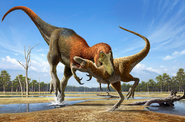| Nanotyrannus Fossil range: Late Cretaceous, 70.6–65.5 Ma | |
|---|---|
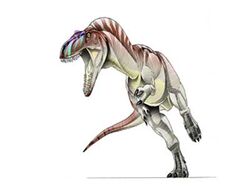 Life restoration of Nanotyrannus. | |
| Scientific classification
| |
| |
Nanotyrannus (meaning "small tyrant") is an extinct genus of tyrannosaurid dinosaur, and is possibly a juvenile specimen of Tyrannosaurus. Nanotyrannus is the smallest known tyrannosaurid and was one of the last tyrannosaurids to before the end-Cretaceous mass extinction, the K-T event.[1] The genus is represented only by a small skull (catalog number CMN 7541), and was discovered by Charles W. Gilmore in 1942 and described in 1946 as a specimen of Gorgosaurus lancensis (now known as Albertosaurus).[2] In 1988, the specimen was re-described by Robert T. Bakker, Phil Currie, and Michael Williams, the late curator of paleontology at the Cleveland Museum of Natural History, where the original specimen was housed and is currently on display.
Opinions continue to remain divided on the validity of N. lancensis. Nanotyrannus can be a possible juvenile of a tyrannosaur that is closely related to Tyrannosaurus and the adult of this animal is yet to be identified, or it really is a juvenile Tyrannosaurus. In either case, an adult Nanotyrannus has to be discovered or a juvenile Tyrannosaurus of the same size as Nanotyrannus but morphologically distinct from it in order to fully resolve this debate. Many paleontologists consider the skull to belong to a juvenile Tyrannosaurus rex. However, there are minor differences between the two species, including the higher number of teeth and the presence of fused bones in the holotype. These features have lead some paleontologists to recommend keeping the two genera separate until further research or discoveries clarify the situation.[3][4]
In 2024, Nick Longrich and Evan Thomas Saitta published a paper after reexamined the holotype and confirmed that Nanotyrannus is a valid species.
Material[]
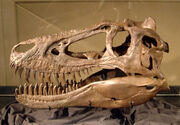
Replica of the skull of "Jane", Burpee Museum of Natural History.
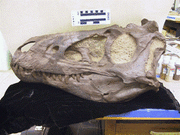
Nanotyrannus ("Gorgosaurus") lancensis, CMNH 7541, Cleveland Museum of Natural History.
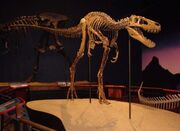
"Jane" at the Burpee Museum in Rockford, Illinois.
A small but nearly complete skull discovered in Montana in 1942 by the Cleveland Museum of Natural History Curator Dr. David Dunkle measured 60 centimeters (2.0 ft) long and may be an exception. The skull was recovered from the upper Lance Formation (the species bear the name lancensis), which is now known as the Hell Creek Formation. This skull, and therefore type species was originally classified as a species of Gorgosaurus (G. lancensis) by Charles W. Gilmore in 1946.[2] In the early 1970s, American paleontologist Dr. Dale Russell of the North Carolina Museum of Natural Sciences, made convincing arguments that the Albertosaurus and Gorgosaurus were the same genus. Because the name Albertosaurus had been in use longer, it became, for a time, the name for all members of both genera. The holotype skull then was assigned the new name Albertosaurus lancensis. However, many paleontologists expressed doubt that the skull was actually Albertosaurus. In the late 1980s, paleontologist Dr. Robert Bakker of the University of Colorado, performed a detailed comparative study[1] and then visited the Royal Tyrrell Museum of Palaeontology in Drumheller, Alberta, Canada, to consult with Dr. Philip Currie, then Head of Dinosaur Research. Together with late Dr. Michael Williams, former Museum Curator of Vertebrate Paleontology from 1975 to 2003, Bakker and Currie published a paper in 1988 describing the new genus and proposing the name Nanotyrannus, which means "pygmy tyrant".[1] The inclusion of the "tyrannus" portion of the name was meant, Williams said, to signal that this was a "downsized tyrannosaur closely related to Tyrannosaurus rex."[5]
Holotype skull[]
Initial research indicated that the skull bones were fused, and that it therefore represented an adult specimen. In light of this, Bakker and colleagues assigned the skull to a new genus, which they named Nanotyrannus for its apparently small size.[1] However, subsequent work has cast doubt on this, and some paleontologists no longer consider it a valid genus—since the fossil was a contemporary of Tyrannosaurus rex, many paleontologists now believe it to be a juvenile T.rex, especially since the discovery in 2001 of a new Nanotyrannus specimen, nicknamed "Jane." The original Nanotyrannus specimen is estimated to have been around 17 feet (5.2 meters) long when it died.
"Jane"[]
- Main article: Jane (dinosaur)
In 2001, a more complete juvenile tyrannosaur ("Jane", catalogue number BMRP 2002.4.1), belonging to the same species as the original Nanotyrannus specimen, was uncovered. It was named after a generous donor to the museum.[5] In 2005, a conference on tyrannosaurs focused on the issues of Nanotyrannus validity brought about by the discovery of the Jane specimen, was held at the Burpee Museum of Natural History. Several paleontologists, such as Phil Currie and Donald M. Henderson, saw the discovery of "Jane" as a confirmation that Nanotyrannus was a juvenile T. rex or closely related species.[6][7]Peter Larson, on the other hand, continued to support a separate genus for Nanotyrannus.[8] The actual scientific study of "Jane", set to be published by Bakker, Larson, and Currie, may help determine whether Nanotyrannus is a valid genus, whether it simply represents a juvenile T. rex, or whether it is a new species of a previously identified genus of tyrannosaur.[9]
Disputed taxonomy[]
Some paleontologists have considered Nanotyrannus to be a synonym of Tyrannosaurus,[10][11][3][12][13][14][15] while others disagree and place it within its own genus.[16][4][17]
Until further specimens are discovered, however, the genus of Nanotyrannus may remain debateable. However, the discovery of a large adult tyrannosaur which is not Tyrannosaurus but instead shows derived features otherwise present only in Nanotyrannus or the discovery of a juvenile tyrannosaur of the same skull length may finally validate the genus.
Nanotyrannus is its own genus[]
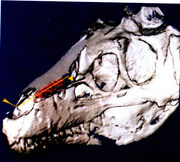
CT scan of the skull of Nanotyrannus.

Skeletal drawing of Nanotyrannus.
Several features seem to separate it from the Tyrannosaurus genus, including the fact that both Jane and the holotype were found in the same area, near Ekalaka, Montana. Both specimens of Nanotyrannus also have 16 teeth, which is two more teeth sockets present in its upper jaw than in Tyrannosaurus.[5] However, there is also considerable evidence for ontogenetic and individual variation in tooth count for tyrannosaurs.[18][19]Nanotyrannus teeth are also described as being more primitive (basal) than that of other tyrannosaurs, in that the teeth were laterally compressed. This feature, however, is not known only to Nanotyrannus, and has also been observed in Alioramus teeth and in the "Jordan theropod", now known as Aublysodon.[20][21][1]
The holotype and "Jane" also have a pneumatic foramen in a bone at the back of the jaw that is not present in Tyrannosaurus.[5] The original specimen of N. lancensis had fused bones, indicating it was an adult, and several paleontologists have suggested that if it was a juvenile T. rex, fossilized remains would most likely be found elsewhere and be more common.[22] A lacrymal horn is present in Nanotyrannus whereas it is absent in Tyrannosaurus. Furthermore, the shape of the lacrymal is "T" shaped in Nanotyrannus but an inverted "L" in Tyrannosaurus.[17]
In the 1998 paper, Bakker et al. described that Nanotyrannus had "strong adaptations for stereoscopic description", which included forward facing eyes, a sharply downward bending neck, and an enlarged temporal region that was four times the width of the muzzle.[1]
Those that support Nanotyrannus as a juvenile Tyrannosaurus mention that "Jane" was only about half grown when she died at around the age of 11.[5] This dispute is not just a simple case of lumping or splitting genera. Nanotyrannus is either a juvenile or not. Some paleontologists hold that the Nanotyrannus holotype is definitely crushed and distorted, and is probably a juvenile Tyrannosaurus. However, that leaves open the advanced state of fusion between the bones of the skull, and whether or not this is just an artifact resulting from the sutures being plastered over by the restorer. Bakker et al. did a CT scan of the Nanotyrannus skull which was able to distinguish between the fossil bone and plaster. The fusion is definitely not from the sutures being plastered over. Nanotyrannus apparently did not have the "eye bones" or "horns" over the eye sockets that Tyrannosaurus had. Furthermore, the eye sockets are located in a different place than on Tyrannosaurus, suggesting Nanotyrannus had binocular vision. However, it should also be noted that horns, being mostly for social interactions of some sort, need not develop until near adulthood, and eye position can easily alter during growth, not contradicting a possible juvenile hypothesis for this genus.
In 2004, Dr. Lawrence Witmer of the College of Osteopathic Medicine at Ohio University, performed a series of Computed Tomography (CT) scans on the holotype skull. The internal shape of the braincase suggests that the tyrannosaur represented by CMNH 7541 could not have grown up to be a Tyrannosaurus.[5] Unfortunately, the braincase for Jane was not recovered so it is impossible to directly compare the only potentially differentiating components of the two animals.[5]
Nanotyrannus is Tyrannosaurus[]

Robert T. Bakker (right), who redescribed Nanotyrannus.
According to Thomas Carr, Nanotyrannus has many juvenile features present in immature tyrannosaurs, and shares a number of derived characters with Tyrannosaurus (such as a narrow snout and broad temporal region), that he placed Nanotyrannus as an early ontogenetic stage of Tyrannosaurus rex.[10] Many authors have followed up on his assessment and dropped the taxonomic validity of Nanotyrannus. Some paleontologists also argue that because some of the skull bones are not fused, it is an immature, juvenile animal. However, if Nanotyrannus had a bimodal growth pattern; a rapid growth from hatchling to subadult, then slower indeterminate growth from subadult to large adult, it could well have had skull-bone fusion already at the subadult stage. This would indicate that that skull-bone fusion may not be as good an indicator of juvenility or sub-adulthood as previously thought.[23] Some have suggested that Nanotyrannus may even be a dromaeosaur, with Robert Bakker suggesting that Nanotyrannus hunted in packs. Teeth from multiple Nanotyrannus have been found in the bones of herbivorous dinosaurs.[24] The type of Nanotyrannus also shares numerous derived attributes with Tyrannosaurus rex which are not found in other tyrannosaurids, as discussed in the next section.
Basal and derived features[]
A wedge-shaped skull, narrow jaw, large orbits, forward-pointing parasphenoid, and infratemporal fenestra without any large rostral process of the quadratojugal and squamosal make it the most basal known tyrannosaur. Not all of these unique features can be attributed to young age, as the skulls of other small tyrannosaurids (Alioramus remotus, Gorgosaurus sternbergi, Maleevosaurus novojilovi) have broad snouts and, in particular, large rostral processes across the infratemporal fenestra.
The type specimen of Nanotyrannus also shares numerous derived attributes with Tyrannosaurus rex which are not found in other tyrannosaurids. Nanotyrannus has a widely expanded occiput relative to snout width (best seen in ventral view in Gilmore's 1946 paper), resulting in orbits having a forward-pointing component. This seems to be a derived feature shared by Nanotyrannus in common with Dinotyrannus and especially Tyrannosaurus. Bakker et al. illustrate the squamosal-quadratojugal junction of Nanotyrannus as more expanded than seen in the photos in Gilmore's 1946 paper, and some paleontologists suspect that the portion within the infratemporal fenestra might be broken off or buried in matrix in the type specimen. But even if this feature is real, it could be a derived character state. These differences between Nanotyrannus and Tyrannosaurus are similar to the differences found between juvenile and adult Gorgosaurus libratus or Tarbosaurus bataar skulls.
Gallery[]
References[]
- ^ a b c d e f Bakker, Williams, and Currie (1988). "Nanotyrannus, a new genus of pygmy tyrannosaur, from the latest Cretaceous of Montana." Hunteria, 1: 1–30.
- ^ a b Gilmore (1946). "A new carnivorous dinosaur from the Lance Formation of Montana." Smithsonian Miscellaneous Collections, 106: 1–19. Cite error: Invalid
<ref>tag; name "gilmore1946" defined multiple times with different content - ^ a b Holtz, Thomas R., Jr. (2004). "Tyrannosauroidea". in David B. Weishampel, Peter Dodson and Halszka Osmólska. The Dinosauria. Berkeley: University of California Press. pp. 111–136. ISBN 0-520-24209-2.
- ^ a b Currie, Philip J. (2003). "Cranial anatomy of tyrannosaurid dinosaurs from the Late Cretaceous of Alberta, Canada" (PDF). Acta Palaeontologica Polonica 42 (2): 191–226. http://www.app.pan.pl/archive/published/app48/app48-191.pdf. Retrieved on 2008-10-09.
- ^ a b c d e f g "Nanotyrannus lancensis". Cleveland Museum of Natural History. http://www.cmnh.org/site/AtTheMuseum/OnExhibit/PermanentExhibits/Nano.aspx. Retrieved on 2009-06-14.
- ^ Currie, Henderson, Horner and Williams (2005). "On tyrannosaur teeth, tooth positions and the taxonomic status of Nanotyrannus lancensis." In "The origin, systematics, and paleobiology of Tyrannosauridae”, a symposium hosted jointly by Burpee Museum of Natural History and Northern Illinois University.
- ^ Henderson (2005). "Nano No More: The death of the pygmy tyrant." In "The origin, systematics, and paleobiology of Tyrannosauridae”, a symposium hosted jointly by Burpee Museum of Natural History and Northern Illinois University.
- ^ Larson (2005). "A case for Nanotyrannus." In "The origin, systematics, and paleobiology of Tyrannosauridae”, a symposium hosted jointly by Burpee Museum of Natural History and Northern Illinois University.
- ^ Mortimer, M (2004). "Tyrannosauroidea". The Theropod Database. http://web.archive.org/20081212143124/home.comcast.net/~eoraptor/Tyrannosauroidea.html#Tyrannosaurusrex. Retrieved on 2007-08-21.
- ^ a b Carr, T.D. 1999. Craniofacial ontogeny in Tyrannosauridae (Dinosauria:Coelurosauria). Journal of Vertebrate Paleontology 19 (3): 497-520
- ^ Carr, T.D., and Williamson, T.E. 2004. Diversity of Late Maastrichtian Tyrannosauridae (Dinosauria:Theropoda) from Western North America. Zoological Journal of the Linnean Society 142: 479-523
- ^ Glut, D. F. 1997. Dinosaurs: The Encyclopedia. McFarland, Jefferson, NC.
- ^ Glut, D. F. 2000. Dinosaurs: The Encyclopedia, Supplement 1. McFarland, Jefferson, NC.
- ^ Glut, D. F. 2003. Dinosaurs: The Encyclopedia, Supplement 3. McFarland, Jefferson, NC.
- ^ Glut, D. F. 2006. Dinosaurs: The Encyclopedia, Supplement 4. McFarland, Jefferson, NC.
- ^ Bakker, R. T. 1986. The Dinosaur Heresies: New Theories Unlocking the Mystery of the Dinosaurs and Their Extinction. Zebra Books, New York.
- ^ a b Larson, N. L. 2008. One Hundred Years of Tyrannosaurus rex: The Skeletons. In K. Carpenter (ed.). Tyrannosaurus Rex:The Tyrant King Indiana University Press, Bloomington.
- ^ Rauhut, Oliver W. & Fechner, Regina, 2005. Early development of the facial region in a non-avian theropod dinosaur. Proc Biol Sci. 272(1568): 1179–1183.
- ^ Smith, Joshua B. 2005. Heterodonty in Tyrannosaurus rex: Implications for the taxonomic and systematic utility of theropod dentitions. Journal of Vertebrate Paleontology 25(4):865-887.
- ^ Molnar, R. 1978. A new theropod dinosaur from the Upper Cretaceous of Central Montana. Journal of Paleontology 52: 73-82
- ^ Molnar, R. E. & Carpenter, K. 1989. The Jordan theropod (Maastrichtian, Montana, U.S.A.) referred to the genus Aublysodon.
- ^ http://dml.cmnh.org/2005Sep/msg00357.html
- ^ http://www.dinosauria.com/jdp/trex/nano.htm
- ^ Nordquist, Karen (2004). Karen's Komments. Earth Science Club of Northern Illinois. Last accessed 2007-03-11.
